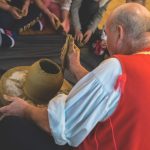
October 29, 2020 – At the foot of Svilaja, close to Lake Peručko, lies the picturesque village of Potravlje, the cradle of Cetina hand-made pottery, a craft whose beginnings date back to prehistoric antiquity of the 4th century BC.
Until the Second World War, about fifty families in the Cetina region villages were engaged in the centuries-old tradition of making earthenware, and about twenty in Potravlje itself. In 1774, the famous Italian travel writer Alberto Fortis claimed that their pots were more durable than those from his homeland.
The traditional hand pottery from Potravlje has been held until today only in this village near Sinj in the municipality of Hrvace.
At the time, households used various earthenware pots, copper for cooking milk or for preparing turkey – rare corn polenta, jars for holding butter and sour milk, pots for storing wine, grain, utensils, peka, cripnje – bell-shaped lids that covered the dough for bread or some other dish on the open hearth, plates for serving dishes, shallow bowls, and drinking jugs. Each had a name according to its purpose (bakra mlikarica, purarica, dubočica, bandeua.
Today, in addition to some traditional dishes, new shapes and purposes are also made, such as amphorae (for tourists), flower pots, and various miniature forms of traditional dishes that are offered as souvenirs. Potters from Potravlje supplied their products to the Cetina region and the wider area of Dalmatia.
They sold their own products at fairs, and they still sell them at the Village Fair in Sinj (every year at the beginning of August before the Alka festivities), at parties in Trilj, Zadvarje, Vrlika, Metković, Benkovac, Split, and elsewhere. Before the Second World War, potters were traveling merchants who distributed goods on donkeys or horses and exchanged them for grain, following the line: “however much grain can fit in a pot, carry it!”. This archaic way of exchanging, bartering, grain goods (or oil, olives, figs) in this area was called promina.
The art of making earthenware in the village of Potravlje has survived to this day in only two families – Jure Knezović (1933-2012), in which today the utensils are made by his sons Ivan (born 1962) and Pile (born 1965), and Jura’s brother Dušan Knezović (born in 1945) in the village of Potravlje.
After a series of successful and well-attended workshops, the Sinj Tourist Board, under the auspices of the Ministry of Culture and Media of the Republic of Croatia, has organized educational workshops “Traditional handmade pottery from Potravlje.” The regular leader of these educational workshops, Mr. Ivan Knezović, is also among the last to work with this traditional craft. It is essential to preserve this segment of Inland Dalmatia’s traditional culture and pass it on to younger generations.
Traditional pottery from Potravlje has had the status of an intangible cultural property since 2013, and the Ministry of Culture of the Republic of Croatia nominated it for UNESCO protection.
Unfortunately, in 2020, due to the coronavirus pandemic, the Sinj Tourist Board could not organize the usual educational workshops and thus adapted the presentation of this valuable skill through a rich photo gallery and video.
You can watch the video below:
https://www.youtube.com/watch?v=v=zO11qLXpDCU












